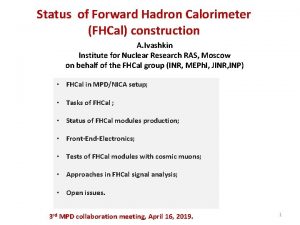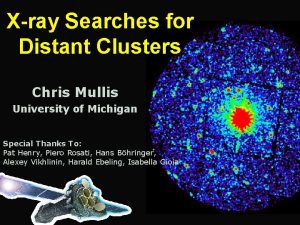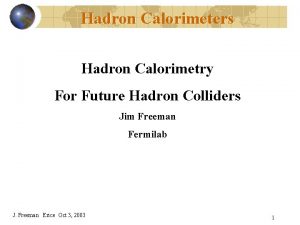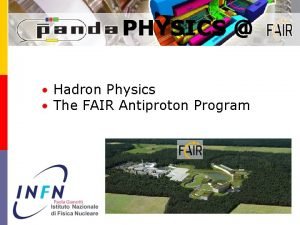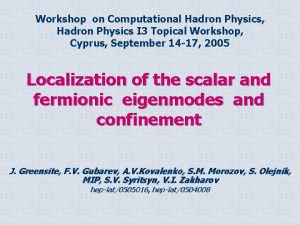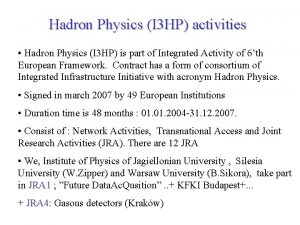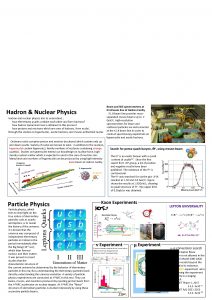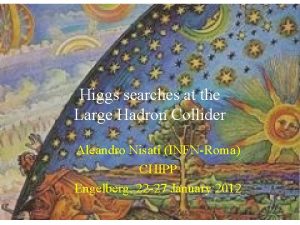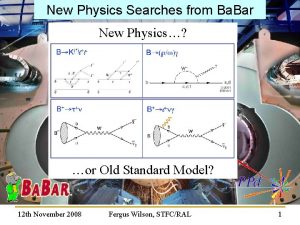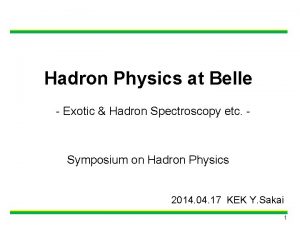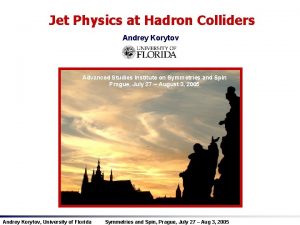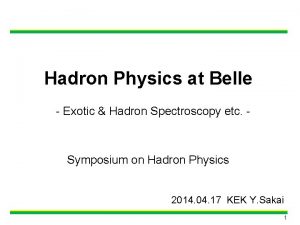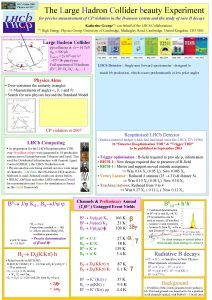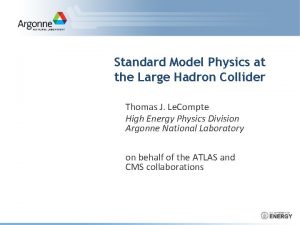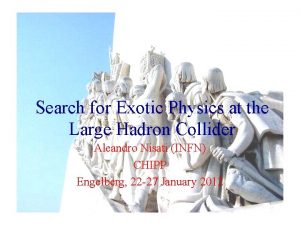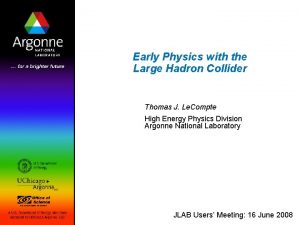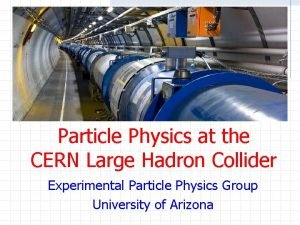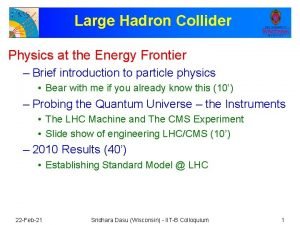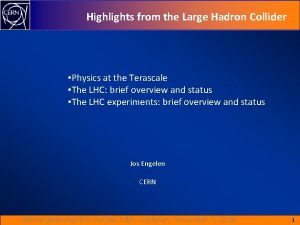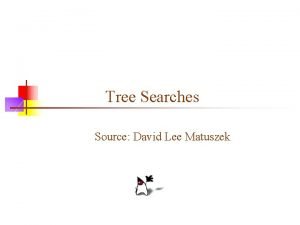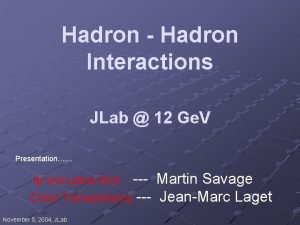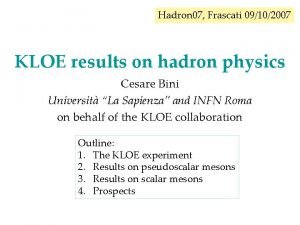Searches for New Physics at the Large Hadron












































































- Slides: 76

Searches for New Physics at the Large Hadron Collider Lecture 2: The Search for Supersymmetry Scottish Universities Summer School in Physics, St. Andrews, 19 August – 1 September 2012 Jeffrey D. Richman Department of Physics University of California, Santa Barbara

Searching for SUSY • SUSY is not one thing: it is a very broad collection of models. Many different signatures and an extensive range of analysis approaches. • Most signatures are not “strong”. For the most part, no sharp peaks. • Nearly all analyses can be criticized. If you look carefully, you will find weak points. • Redundancy and multiple, cross-checking analyses using different methods are valuable (essential) if we are going to believe that an excess of events corresponds to new physics.

SUSY Outline • Inclusive SUSY searches based on topologies – Methods for SUSY interpretation • Searches motivated by “naturalness” (3 rd generation squarks and not too heavy gluinos) In Lecture 3 • Direct production of neutralinos & charginos • Hiding SUSY (“exotic models”) – Long lived particles (e. g. , long-lived gluinos in split SUSY) – R-parity-violating SUSY (See Lec 1 for monojet, monophoton discussion. )

ATLAS SUSY Results There is a lot of territory here. . . Mass scale (Te. V)

ATLAS SUSY Results Inclusive searches 3 rd gen. , gluon mediated 3 rd gen. , direct production Electroweak SUSY direct production Long-lived particles R-parity violating SUSY Other. . . monojets, etc. Prev. lecture But it’s not as scary as it looks: a few basic ideas, many channels

This year could be very interesting. . . or not! http: //arxiv. org/abs/1206. 6888 v 1 Come back to this in next lecture.

SUSY particle production at √s=8 Te. V Courtesy T. Plehn (http: //www. thphys. uni-

Gluino production in pp collisions For production cross section calculations, the squark masses are often taken to be arbitrarily large – the “decoupling limit”.

Gluino pair production (√s=7 Te. V) M. Kramer et al. , http: //ar. Xiv/abs/1206. 2892 Calculated assuming all squarks have high mass & decouple.

Gluinos: fundamental vertices with squarks • SUSY preserves the gauge symmetries, so the SUSY partners of the gluons must also transform according to the 8 -dimensional representation of SU(3)C. • Fundamental vertex for has same coupling strength as that for. SUSY

Gluino decays to lighter and heavier squarks • Two cases 2 -body decay 3 -body decay (suppressed) 3 -body decay is analogous to weak decay of low mass fermions, e. g. , b c l ν via a virtual W.

Decay table for gluinos in LM 6 Number decay modes = 4 x(5 flavors) + 2 = 22 That’s a lot!

Squark decay to/via neutralino decay to/via gluino decay to/via chargino decay to/via W, Z, h


Decay tables for stop 1, 2 in LM 6

Starting from gluinos. . . Direct production via strong processes SUSY LM 6 benchmark Nobody knows how many squarks would be lighter than the gluino: maybe 0, 1, 2, 3, ? ? ? e. g. , split supersymmetry! neutralino (LSP) Direct production via electroweak processes

Things can start to get complicated Direct production via strong processes SUSY LM 6 benchmark neutralino (LSP) Direct production via electroweak processes Things can get pretty complicated. . . and there are many scenarios!

Strategy for SUSY with complex decay patterns • Complex decay patterns, not dominated by any one (or even few) modes, can emerge in many models. • Inclusive search strategies, based on simple topological signatures are well suited to such cases. • Inclusive searches (can require b jets in all cases) – Jets + MET (or similar variable) – 1 lepton + Jets + MET – Dileptons + Jets + MET (same- or opp-sign dileptons) Also on the menu: can add – Single photon + jets + MET b-jets, tau leptons to most items! Opp. sign dileptons: – Two photons + jets + MET can add Z bosons.

CMS: Multijets + MHT search (7 Te. V) CMS, http: //arxiv. org/pdf/1207. 1898. pdf • Search variables: Why not use MET? Data-driven method for QCD background uses jet-smearing method! • Require ≥ 3 jets, p. T>50 Ge. V, |η|<2. 5 • ttbar, W+jets suppression: veto events with isolated leptons with p. T>10 Ge. V. • QCD suppression: veto events with Δφ(MET, Jet 1)<0. 5. Similar cuts for Jet 2, Jet 3.

Background schematic for searches with MET Key Background Processes QCD multijet production W+jets W lep Z/DY+ jets Z νν QCD: Fake MET from mismeasured jet is usually aligned with jet & dominated by single jet. Also true for b c l ν. Jets + MET (all-hadronic SUSY search) ttbar + jets ttbar 1 lep ttbar + jets ttbar 2 lep Key Search Channels Jets + 1 lepton + MET Jets +Opp sign dileptons + MET Jets +Same sign dileptons + MET

Background schematic for searches with MET Key Background Processes QCD multijet production W+jets W lep Z/DY+ jets Z νν Real MET from W l ν, l = (e, μ), W τ ν; τ (e, μ) W τ ν; τ jets. . . with leptons -below p. T thresh. -escaping isol veto -not reconstructed Jets + MET Jets + 1 lepton (all-hadronic + MET SUSY search) ttbar + jets ttbar 1 lep ttbar + jets ttbar 2 lep Key Search Channels Jets +Opp sign dileptons + MET Jets +Same sign dileptons + MET

Background schematic for searches with MET Key Background Processes QCD multijet production W+jets W lep Z/DY+ jets Z νν Real MET from νν “Irreducible background”. Measured using Z l+l- or gamma + jets Jets + MET (all-hadronic SUSY search) Jets + 1 lepton + MET ttbar + jets ttbar 1 lep ttbar + jets ttbar 2 lep Key Search Channels Jets +Opp sign dileptons + MET Jets +Same sign dileptons + MET

http: //arxiv. org/pdf/1206. 6064. pdf

Background schematic for searches with MET Key Background Processes QCD multijet production W+jets W lep Z/DY+ jets Z νν ttbar + jets ttbar 1 lep Lost lepton (real MET from ν) Real MET from W l ν, l = (e, μ), W τ ν; τ (e, μ) W τ ν; τ jets Jets + MET (all-hadronic SUSY search) Jets + 1 lepton + MET ttbar + jets ttbar 2 lep Key Search Channels Jets +Opp sign dileptons + MET Jets +Same sign dileptons + MET

Background schematic for searches with MET Key Background Processes QCD multijet production W+jets W lep Z/DY+ jets Z νν ttbar + jets ttbar 1 lep ttbar + jets ttbar 2 lep Lots of MET, but hard to lose 2 leptons; Also has fewer jets. Key Search Channels Jets + MET (all-hadronic SUSY search) Jets + 1 lepton + MET Jets +Opp sign dileptons + MET Jets +Same sign dileptons + MET

CMS inclusive jets + MHT search http: //arxiv. org/pdf/1207. 1898. pdf Distributions of HT and HTmiss for events passing the baseline selection Backgrounds are from data-driven estimates, not MC. SUSY LM 5 benchmark model (overlaid) Compare QCD behavior! LM 5: m 0 = 230 Ge. V, m 1/2 = 360 Ge. V, A 0 = 0, tan b = 10, and sgn(m) > 0

Yields vs. predictions by signal region full MHT range

c. MSSM exclusion region for jets + MHT search For this c. MSSM param set, squark masses below 1. 2 Te. V and gluino masses below 720 Ge. V are excluded. But these conclusions are not generic. . . Must be extremely careful about drawing broad conclusions from c. MSSM! In the c. MSSM/m. SUGRA, the gluino mass can’t be too far above the squark masses.

Constraints in the m( ) vs. m( ) plane

Limitations of c. MSSM interpretation • People liked c. MSSM because it reduced 105 parameters to just 5, defined at the GUT scale: common sfermion mass: m 0 common gaugino mass: m 1/2 common trilinear coupling A 0 ratio of vac. expectation values for up-type & -type fermions: tanβ – sign of Higgsino mass parameter: μ – – great for making pretty plots! down • The interpretation of SUSY results in terms of c. MSSM/m. SUGRA parameter space is considered ~obsolete. • The c. MSSM incorporates contraints at the GUT scale that are not well motivated. These can lead to spectra

Simplified models: a new paradigm http: //arxiv. org/abs/1105. 2838 • To reduce the number of NP parameters, use very simple particle spectra. Masses specified at EW scale. • Each model based on an effective Lagrangian relevant for a particular process of interest. • Experimenters establish upper limits on the cross section for the simplified model, for given masses.

Simplified models: examples T 2 bb T 2 tt T 1 bbbb T 1 tttt Tn=Topology n; n= even squark production (gluino decoupled); n=odd gluino production (squark decoupled); see CMS PAS SUS-11 -016. http: //cdsweb. cern. ch/record/1445580.

Simplified model interpretation: CMS jets + MHT (7 Te. V) Gluino production with 3 -body decay Direct squark production with 2 -body decay to LSP n o gi IS R g re n i s itt thi l sp for s l as tica l m cr l a g m S elin od m Generic turn-over as spectrum compresses! ( softer jets, softer MET spectrum) less sensitivity. Expt limit Paradigm shift: now quote the upper limit on the cross section for the given topology.

Inclusive SUSY searches with leptons • The decay of squarks can produce neutralinos, charginos, W and Z bosons. All of these can produce leptons. • Leptons are your friends. • Lepton isolation is a powerful tool for suppressing QCD background and for measuring how much remains. • ttbar is almost always a key background. • W, Z are more important for low numbers of jets. • b tagging suppresses W, Z.

Starting from gluinos. . . SUSY LM 6 benchmark neutralino (LSP)

Decays of ~t 2 neutralinos, charginos, Z. . . SUSY LM 6 benchmark neutralino (LSP)

Decays of ~t 1 neutralinos, charginos SUSY LM 6 benchmark neutralino (LSP)

Decays of : here come the leptons! SUSY LM 6 benchmark neutralino (LSP)

Decays of : more leptons! SUSY LM 6 benchmark neutralino (LSP)

Decay table for continued in LM 6

Decay table for in LM 6 (continued) Decay table for in LM 6

ATLAS: Multijets + 1 lepton + MET (8 Te. V) ATLAS, http: //atlas. web. cern. ch/Atlas/GROUPS/PHYSICS/CONFNOTES/ATLAS-CONF-2012 -104/ • Search variables: • • • (many thanks to Jeannette Lorenz!) Require ≥ 4 jets, p. T>80 Ge. V, 1 isolated lepton p. T>25 Ge. V MT(l, MET)>100 Ge. V: suppresses single-lepton SM Veto event if has 2 nd lepton p. T>10 Ge. V Suppresses ttbar dileptons. Separate 1 lep & 2 lep meas. Perform fit to data in signal and control regions.

Signal and control regions for ATLAS analysis Control region divided into 4 subsamples: - ttbar e ν: electron + b-tag - ttbar μ ν: muon + b-tag - (W e ν) + jets: electron + anti-b-tag - (W μ ν) + jets: muon + anti-b-tag Signal region divided into e and mu subsamples Low ETmiss and HT suppress signal contamination.

Data vs. MC comparison: e and mu MC out-of-the-box predictions for backgrounds (not used for final result) W + jets control region (anti-b tagged) CONTROL ttbar control region (anti-b tagged) CONTROL SUSY model 0. 08 pb

Yields and fits in the control regions b tagging separates the main backgrounds. small big small Perspective: how many ttbar and W+jets were produced? Background Cross section (pb) Cross sec * BR Events produced Rejection W l nu + jets 12, 190 70. 78 × 106 2. 8 × 10 -7 ttbar 238*(12/81)=35. 3 0. 20 × 106 238 2 × 10 -4 Huge suppression of W+jets not surprising you can’t use MC value!

Yields and fits in the control regions b tagging separates the main backgrounds. Total observed small big small Fitted ttbar Fitted W/Z QCD is small! Good thing fit is done! Wow! Close to fit values! Perspective: how many ttbar and W+jets were produced? Background Cross section (pb) Cross sec * BR Events produced Rejection W l nu + jets 12, 190 70. 78 × 106 2. 8 × 10 -7 ttbar 238*(12/81)=35. 3 0. 20 × 106 238 2 × 10 -4 Huge suppression of W+jets not surprising you can’t use MC value!

Apply fit params from control region to background MC for signal region e signal region (no b-tagging applied) mu signal region (no b-tagging applied) SUSY benchmark Observed yield Predicted background SUSY benchmark electron muon 10 4 9. 0 ± 2. 8 7. 7 ± 3. 2

ATLAS c. MSSM exclusion region (8 Te. V) Benchmark (400, 500) Ge. V Takes into account model-by-model signal contamination of control regions.

The famous neutralino dilepton cascade Opposite-sign, same flavor leptons The can be produced in any process, not just direct EW production. Can produce sharp edge at upper limit of dilepton mass spectrum corresponding to kinematic cutoff.

The famous SUSY trilepton signature The can be produced in any process, not just direct EW production.

“Natural SUSY endures”: the current fashion M. Papucci, J. T. Ruderman, and A. Weiler http: //arxiv. org/abs/1110. 6926

not just one scenario. . . Some spectra compatible with “naturalness” considerations M. Papucci, J. T. Ruderman, and A. Weiler, http: //arxiv. org/abs/1110. 69 26 What sort of strategy should we use for this? Clearly, b-tagging will play a big role. Have to consider production & decay. See also D. Alves, M. Buckley, P. Fox, J. Lykken, and C. -T. Yu http: //arxiv. org/abs/1205. 5805

Production of scalar top (“stop”) Very nice discussion in “Supersymmetric top and bottom squark production at hadron colliders”, Beenakker et al. ar. Xiv: 1006. 4771. • Even for m(~t)=m(t), the cross section is much lower than that for ttbar, as a consequence of spinrelated effects. • If we find stop, and can determine its mass, then the small rate would be a probe of the spin.

Light stop decay Not allowed, assuming stop is lightest squark Not allowed assuming stop is lightest squark

“Direct” pair production of light stops Example: direct stop production with decay to neutralinos or charginos. Sensitivity of the searches will depend strongly on the neutralino mass. The channel with has sensitivity to lower stop mass.

Production cross section for low-mass stop M. Kramer et al. , ar. Xiv: 1206. 2892 Even at the same mass, st-stbar production is suppressed relative to ttbar production.

Stop pair production: disappointingly small M. Kramer et al. , ar. Xiv: 1206. 2892 For 5 fb-1, get 1000 events for m(stop) = 400 Ge. V! Sounds easy. . . But σ(ttbar) = 175 pb is about 900 x larger!

Gluino pair production and decay to light stop Maybe the gluinos aren’t too heavy – very large production cross section may make gluino pair production competitive. The production of four top quarks and additional MET can lead to spectactular signatures.

Strategies/issues for light stop • With b-tagging, ttbar dominates the background. • Direct production: – -ttbar + extra MET; correlations between t and tbar are affected (e. g. , p. T of top quarks can differ a lot). – Need to exploit kinematic differences between stop signals and ttbar. (Helpful if there are lots of signal events are around. ) • Gluino pair production: 4 top quarks + MET! – many jets; 4 b jets – can have multileptons, including same-sign leptons – many useful features as long as cross section isn’t suppressed by too large gluino mass.

ttbar as a SUSY background For a ttbar event to produce large MET (100 -200 Ge. V) , need at least one W l ν, l = e, μ, τ). reduces Njets. ISR Searches for SUSY in hadronic channels benefit from lepton vetoes. τ-leptons are a problem!

Direct stop production: 0 leptons ATLAS collaboration, ar. Xiv: 1208. 1447 • Require ≥ 6 jets, p. T(leading)>130 Ge. V, p. T>30 Ge. V for 5 other jets. • 80<M(jjj)>270 Ge. V for consistency with top 1 lep control region – both triplets • Suppression of ttbar; W τν – if tau-like jet has MT(jet, MET)<100 Ge. V reject event. • Require either one tight b jet or two loose b jets • MET must not be ~collinear with any jet m. T: tau-like jets

Search for direct stop production: 0 lepton ATLAS collaboration, ar. Xiv: 1208. 1447 SRA

ATLAS searches for direct stop production (analysis shown) Stop excluded up to ~500 Ge. V, but strong dependence on

Searches with like-sign dileptons and b-jets Like-sign dileptons are a classic SUSY signature. With multiple b-jets the signature becomes quite strong.

Like-sign dileptons from b-squark pairs Can also get like-sign dileptons and multileptons from b-quark pair production. Also have b-jets here.

Same-sign dileptons: experimental issues ttbar dilepton background: normally opposite-sign isolated leptons; highly suppressed by like-sign selection. primary lepton

Same-sign dileptons: experimental issues secondary lepton, accidentally isolated Will be same-sign with respect to primary lepton from other top decay. primary lepton The number of such isolated leptons from b decay is small, but it must be determined very carefully from data (“fake rate” for secondary lepton to look like a primary lepton).

Like-sign dileptons + b jets CMS–SUS-12 -017 http: //cdsweb. cern. ch/record/1459811 Backgrounds 1. primary-secondary pairs 2. lepton charge mis-ID (e bremstrahlung) 3. rare SM processes: ttbar+W, ttbar+Z (~200 fb each) Selection 2 same-sign leptons (p. T>20 Ge. V), ≥ 2 b jets (p. T>40)

Like-sign dileptons + b-jets results gluino pairs, virtual stops gluino pairs, real stops ATLAS-CONF-2012 -105 sbottom pair production

Limits on gluino pair production to 4 b quarks

Conclusions • SUSY searches are evolving from inclusive measurements to more focussed searches, especially for light stop/sbottom. • The simplified-model approach is replacing CMSSM for interpretations. • “Naturalness”-motivated searches are just beginning. The 2012 data sample will be extremely important for natural SUSY models. • Tomorrow: Electroweak production and “exotica”.

Backups

Some spectra compatible with “naturalness” considerations M. Papucci, J. T. Ruderman, and A. Weiler, http: //arxiv. org/abs/1110. 6926 What sort of strategy should we use for this? Clearly, b-tagging will play a big role. Have to consider production & decay.


Limits on stop production - CMS

 Hadron calorimeter
Hadron calorimeter Hadron collider
Hadron collider Hadron collider
Hadron collider Hadron
Hadron Hadron
Hadron 2711 se loop 410 south
2711 se loop 410 south Xray searches
Xray searches Modern physics vs classical physics
Modern physics vs classical physics University physics with modern physics fifteenth edition
University physics with modern physics fifteenth edition Physics ia research question ideas
Physics ia research question ideas Fspos vägledning för kontinuitetshantering
Fspos vägledning för kontinuitetshantering Typiska drag för en novell
Typiska drag för en novell Tack för att ni lyssnade bild
Tack för att ni lyssnade bild Ekologiskt fotavtryck
Ekologiskt fotavtryck Shingelfrisyren
Shingelfrisyren En lathund för arbete med kontinuitetshantering
En lathund för arbete med kontinuitetshantering Kassaregister ideell förening
Kassaregister ideell förening Personlig tidbok för yrkesförare
Personlig tidbok för yrkesförare A gastrica
A gastrica Vad är densitet
Vad är densitet Datorkunskap för nybörjare
Datorkunskap för nybörjare Stig kerman
Stig kerman Debattartikel mall
Debattartikel mall Magnetsjukhus
Magnetsjukhus Nyckelkompetenser för livslångt lärande
Nyckelkompetenser för livslångt lärande Påbyggnader för flakfordon
Påbyggnader för flakfordon Tryck formel
Tryck formel Svenskt ramverk för digital samverkan
Svenskt ramverk för digital samverkan Kyssande vind analys
Kyssande vind analys Presentera för publik crossboss
Presentera för publik crossboss Argument för teckenspråk som minoritetsspråk
Argument för teckenspråk som minoritetsspråk Bat mitza
Bat mitza Klassificeringsstruktur för kommunala verksamheter
Klassificeringsstruktur för kommunala verksamheter Fimbrietratt
Fimbrietratt Bästa kameran för astrofoto
Bästa kameran för astrofoto Centrum för kunskap och säkerhet
Centrum för kunskap och säkerhet Programskede byggprocessen
Programskede byggprocessen Bra mat för unga idrottare
Bra mat för unga idrottare Verktyg för automatisering av utbetalningar
Verktyg för automatisering av utbetalningar Rutin för avvikelsehantering
Rutin för avvikelsehantering Smärtskolan kunskap för livet
Smärtskolan kunskap för livet Ministerstyre för och nackdelar
Ministerstyre för och nackdelar Tack för att ni har lyssnat
Tack för att ni har lyssnat Referat mall
Referat mall Redogör för vad psykologi är
Redogör för vad psykologi är Stål för stötfångarsystem
Stål för stötfångarsystem Tack för att ni har lyssnat
Tack för att ni har lyssnat Borra hål för knoppar
Borra hål för knoppar Vilken grundregel finns det för tronföljden i sverige?
Vilken grundregel finns det för tronföljden i sverige? Fr formel
Fr formel Tack för att ni har lyssnat
Tack för att ni har lyssnat Rita perspektiv
Rita perspektiv Ledningssystem för verksamhetsinformation
Ledningssystem för verksamhetsinformation Tobinskatten för och nackdelar
Tobinskatten för och nackdelar Toppslätskivling effekt
Toppslätskivling effekt Gibbs reflekterande cykel
Gibbs reflekterande cykel Egg för emanuel
Egg för emanuel Elektronik för barn
Elektronik för barn Antika plagg
Antika plagg Strategi för svensk viltförvaltning
Strategi för svensk viltförvaltning Kung som dog 1611
Kung som dog 1611 Humanitr
Humanitr Sju för caesar
Sju för caesar Tack för att ni lyssnade
Tack för att ni lyssnade Större än
Större än Dikt bunden form
Dikt bunden form Inköpsprocessen steg för steg
Inköpsprocessen steg för steg Rbk-mätning
Rbk-mätning Etik och ledarskap etisk kod för chefer
Etik och ledarskap etisk kod för chefer Skivepiteldysplasi
Skivepiteldysplasi Myndigheten för delaktighet
Myndigheten för delaktighet Trög för kemist
Trög för kemist Sju principer för tillitsbaserad styrning
Sju principer för tillitsbaserad styrning Läkarutlåtande för livränta
Läkarutlåtande för livränta Brant karttecken
Brant karttecken Gumman cirkel sång
Gumman cirkel sång Texter för hinduer tantra
Texter för hinduer tantra
